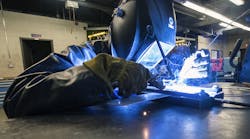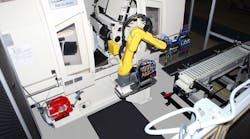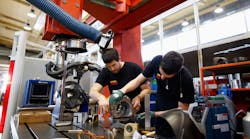Demand for metal fabrications is forecast for impressive growth in several markets during the coming years. At the same time, metal fabricating operations will be specializing and investing in an explosion of new technologies and skills, in order to maximize their opportunities for growth. Businesses that want to thrive in a changing global economy, including metal fabricating companies, need to balance investments in skills and labor with selecting emerging technologies and implementing spotless customer service. To build a successful metal fabricating business in this atmosphere, consider this a quick guide.
Focus on core competencies — A report prepared by Beroe found that the global demand for fabricated metal products will be driven largely by building and piping, construction, and architecture projects. On the other hand, the same data indicates no real increase in demand for metal fabrication in the automotive market: a holding pattern, in other words. Steady work without a lot of opportunity for growth right now.
It's important to know about trends like these. That foresight helps growing companies identify and focus on worthwhile core competencies, and avoid investing talent and equipment in services that will not have the desired growth.
Fill unmet specialty needs — At the same time, there may be an opportunity to corner the market on a skill or service that’s hard to find and that may become lucrative, if you choose to focus on it. Some of the potentially profitable avenues to take in metal fabricating services now include:
• Mobile welding and on-demand maintenance services;
• Underwater and high-risk welding;
• Stainless steel and other high-ticket fabrications;
• Aluminum welding, including ship-building applications;
• Steel and aluminum building products.
There are other variables to consider, too. For example, when the economy is behaving less predictably than people would like, military and government contracting work can prove more stable by comparison.
Fabrication of any kind requires a lot of capital and may leave a business more vulnerable to the market forces than other activities may do. You'll be rewarded if you remain plugged in to market developments, and learn to see opportunities that others miss.
Partner with technical schools — Technical schools are great resources for people who have an interest in fabricating, metalworking, and welding — and for businesses that want to find those people. Technical schools frequently offer boot camps where applicants can receive basic job-readiness training and even job offers upon completion.
Metal fabricating businesses may tap a steady flow of new talent by developing relationships with schools like these.
Know what relevant skills are worth — There’s a lot to learn from the recent histories of companies that rely on welders and other kinds of metal fabricating expertise. Amerequip Corp., a major fabricator of custom metal parts and industrial products, found itself turning down work in 2017 and 2018 because it didn’t have the staff on hand to meet clients' demands. Things turned around when the company boosted wages to $15/ and $18/hour minimum for welders and other skilled staff. Amerequip even had enough committed employees and enthusiastic clients that it added a new weekend shift at even higher wages.
Clearly, compensation is a big factor in sustaining growth and retaining engaged talent at a time when companies need it more than ever.
Invest in new technologies — McKinsey estimates that the 3D printing market could grow to a $10-billion enterprise by 2035. For metal fabricating companies that want to stay relevant, this moment in the development of 3D printers is a potentially unique opportunity.
As McKinsey notes, adopting 3D printing shortens the value chain considerably and helps fabricating companies retain greater control over their manufacturing processes. This possibility is one reason the global market for 3D-printed metals is expected to grow at a CAGR of 28.8% between 2018 and 2023.
Industrial 3D printers also are cost-effective at a smaller scale, which means they support the growth of metal fabricating companies that want to maintain investments in and ties to the local region and community. Within the current political and social realities, there’s plenty of reason to try to “keep it local.”
Of course, 3DP/additive manufacturing is just one example of a technology trend that’s shaping the development of up-and-coming metal fabricating companies. Growth-conscious manufacturers should stay alert for other, similar developments.
Automate wisely — It should be noted that Amerequip didn’t survive just by raising its minimum wages; it also made wise investments in automation wherever that made good sense.
Automated material handling systems, including automated guided vehicles (AGVs) and automated storage and retrieval systems (ASRS), are achieving ever-wider adoption by this and other companies in the metal fabricating sector.
It takes fewer and fewer human bodies to move materials and workpieces through an assembly line: from material storage areas, through laser cutters and CNC machines, and finally to inspection and packaging operations. That means the skilled employees you bring aboard can take these potentially unsafe, lower-skilled tasks off their plate and focus on more demanding, more detail-oriented and higher-paying work instead.
Achieving workforce engagement and stability isn’t a matter of avoiding new technologies, but it does require that companies find the right balance between people and machines. Almost any workflow that can be reworked for greater safety and efficiency is an investment worth considering — and it will let you put more of your attention on the reasons you got into this business in the first place.
Commit to spotless customer service — There are a few things you cannot fake in metal fabricating or any other industry, and one is customer service. It must be a marquee trait of any growing company.
Put yourself in your clients’ shoes and remind yourself what of the type of service you’d want if the roles were reversed. You’d expect quick turnarounds on quotes and projects, always-on availability, and transparency in billing and all other financial matters. This is where enterprise resource planning (ERP), client relationship management (CRM) and other software-based services come in. For companies that want to even further fine-tune their responsiveness to customer inquiries and make data more mobile in two directions, chatbots are now a major part of the equation.
Of course, customer service is ultimately about remaining accountable to the public and maintaining ties to the community. Wherever success takes you in this industry, that’s one thing worth remembering.
Megan Nichols is a STEM writer and blogger covering a wide range of scientific topics at schooledbyscience.com. Recently, she looked into What Are the Trends Shaping Modern Machining?, and she described How to Optimize Your Metal Fabrication Shop. Follow Megan on Twitter @nicholsrmegan.








